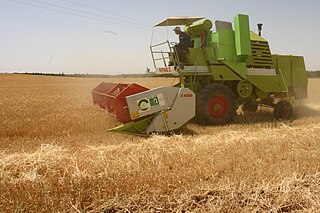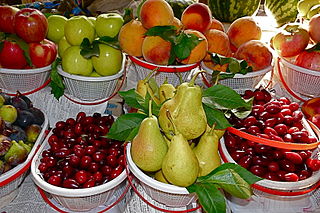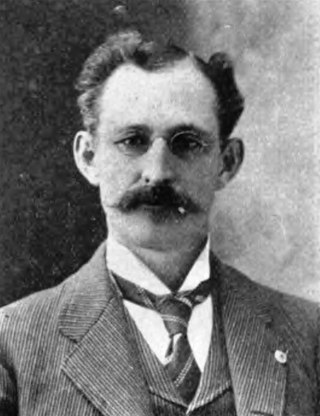Related Research Articles

A commodity market is a market that trades in the primary economic sector rather than manufactured products, such as cocoa, fruit and sugar. Hard commodities are mined, such as gold and oil. Futures contracts are the oldest way of investing in commodities. Commodity markets can include physical trading and derivatives trading using spot prices, forwards, futures, and options on futures. Farmers have used a simple form of derivative trading in the commodity market for centuries for price risk management.

Hermiston is a city in Umatilla County, Oregon, United States. Its population of 19,973 makes it the largest city in Eastern Oregon. Hermiston is the largest and fastest-growing city in the Hermiston-Pendleton Micropolitan Statistical Area, the eighth largest Core Based Statistical Area in Oregon with a combined population of 92,261 at the 2020 census. Hermiston sits near the junction of I-82 and I-84, and is 7 miles south of the Columbia River, Lake Wallula, and the McNary Dam. The Hermiston area has become a hub for logistics and data center activity due to the proximity of the I-82 and I-84 interchange, Pacific Northwest fiber optic backbone, and low power costs. The city is also known for its watermelons, which are part of its branding.

Othello is a city in Adams County, Washington, United States. The population was 8,549 at the 2020 census, a 16 percent increase from 2010. It is located in the heart of the Columbia Basin Project, approximately 100 miles (160 km) southwest of Spokane. The city is 25 miles (40 km) south of Interstate 90 in Moses Lake and is connected by State Route 17 and State Route 26.

The Chicago Mercantile Exchange (CME) is a global derivatives marketplace based in Chicago and located at 20 S. Wacker Drive. The CME was founded in 1898 as the Chicago Butter and Egg Board, an agricultural commodities exchange. For most of its history, the exchange was in the then common form of a non-profit organization, owned by members of the exchange. The Merc demutualized in November 2000, went public in December 2002, and merged with the Chicago Board of Trade in July 2007 to become a designated contract market of the CME Group Inc., which operates both markets. The chairman and chief executive officer of CME Group is Terrence A. Duffy, Bryan Durkin is president. On August 18, 2008, shareholders approved a merger with the New York Mercantile Exchange (NYMEX) and COMEX. CME, CBOT, NYMEX, and COMEX are now markets owned by CME Group. After the merger, the value of the CME quadrupled in a two-year span, with a market cap of over $25 billion.


Clayton Keith Yeutter, ONZM was an American politician who served as United States secretary of agriculture under President George H. W. Bush from 1989 to 1991 before serving as counselor to the president in 1992. He served as United States trade representative from 1985 to 1989 and as chairman for the Republican National Committee from 1991 until 1992. Yeutter was employed as a senior advisor at the international law firm Hogan Lovells in Washington, D.C. He additionally founded the Clayton Yeutter Institute of International Trade and Finance at his alma mater, the University of Nebraska–Lincoln. The university subsequently published his biography, Rhymes with Fighter.

Daniel Robert Glickman is an American politician, lawyer, lobbyist, and nonprofit leader. He served as the United States secretary of agriculture from 1995 until 2001 in the Clinton administration. He previously represented Kansas's 4th congressional district as a Democrat in the U.S. House of Representatives for 18 years.

The Tualatin Valley is a farming and suburban region southwest of Portland, Oregon. The valley is formed by the meandering Tualatin River, a tributary of the Willamette River at the northwest corner of the Willamette Valley, east of the Northern Oregon Coast Range. Most of the valley is located within Washington County, separated from Portland by the Tualatin Mountains. Communities in the Tualatin Valley include Banks, Forest Grove, Cornelius, Hillsboro, Aloha, Beaverton, Sherwood, Tigard, and Tualatin.

John Richard Simplot was an American entrepreneur and businessman best known as the founder of the J. R. Simplot Company, a Boise, Idaho–based agricultural supplier specializing in potato products. In 2007, he was estimated to be the 89th-richest person in the United States, at $3.6 billion. At the time of his death at age 99 in May 2008, he was the oldest billionaire on the Forbes 400.

The J. R. Simplot Company is an agribusiness company headquartered in Boise, Idaho.

The Treasure Valley is a valley in the western United States, primarily in southwestern Idaho, where the Payette, Boise, Weiser, Malheur, Owyhee, and Burnt rivers drain into the Snake River. It includes all the lowland areas from Vale in rural eastern Oregon to Boise, and is the most populated area in Idaho.

Washington wine is a wine produced from grape varieties grown in the U.S. state of Washington. Washington ranks second in the United States in the production of wine. By 2017, the state had over 55,000 acres (220 km2) of vineyards, a harvest of 229,000 short tons (208,000 t) of grapes, and exports going to over 40 countries around the world from the 940+ wineries located in the state. While there are some viticultural activities in the cooler, wetter western half of the state, the majority (99.9%) of wine grape production takes place in the shrub-steppe eastern half. The rain shadow of the Cascade Range leaves the Columbia River Basin with around 8 inches (200 mm) of annual rain fall, making irrigation and water rights of paramount interest to the Washington wine industry. Viticulture in the state is also influenced by long sunlight hours and consistent temperatures.

The Yakima Valley AVA was the first American Viticultural Area established within Washington state, gaining the recognition in 1983. Part of the larger Columbia Valley AVA, Yakima Valley AVA is home to more than 18,000 acres (73 km2) of vineyards, giving the area the largest concentration of wineries and vineyards in the state. The most widely planted varietals in the area are Chardonnay, Riesling, Merlot, Cabernet Sauvignon, Pinot gris, and Syrah. Nearly 40% of Washington state yearly wine production is made from Yakima Valley grapes. In addition to grapes, the Yakima Valley is also home to several fruit orchards growing apples, cherries, nectarines, peaches, pears and plums. Around the town of Zillah, there is the Zillah Fruit Loop driving tour through the area's orchards and vineyards. The area is also home to nearly 80% of the US hop production.

Agriculture in Algeria composes 25% of Algeria's economy and 12% of its GDP in 2010. Prior to Algeria’ colonization in 1830, nonindustrial agriculture provided sustenance for its population of approximately 2-3 million. Domestic agriculture production included wheat, barley, citrus fruits, dates, nuts, and olives. After 1830, colonizers introduced 2200 individual farms operated by private sectors. Colonial farmers continued to produce a variety of fruits, nuts, wheat, vegetables. Algeria became a large producer of wine during the late 19th century due to a crop epidemic that spread across France. Algeria's agriculture evolved after independence was achieved in 1962. The industry experienced multiple policy changes modernize and decry on food imports. Today, Algeria's agriculture industry continues to expand modern irrigation and size of cultivable land.

Armenia has 2.1 million hectares of agricultural land, 72% of the country's land area. Most of this, however, is mountain pastures, and cultivable land is 480,000 hectares, or 16% of the country's area. In 2006, 46% of the work force was employed in agriculture, and agriculture contributed 21% of the country's GDP. In 1991 Armenia imported about 65 percent of its food.

Agriculture in Cyprus constituted the backbone of its economy when it achieved its independence in 1960. It mostly consisted of small farms, and sometimes even subsistence farms. During the 1960s, irrigation projects made possible vegetable and fruit exports; increasingly commercialized farming was able to meet the demands for meat, dairy products, and wine from the British and United Nations troops stationed on the island and from the growing number of tourists.

William Henry Wehrung was an American businessman and politician in the state of Oregon. A native Oregonian, he was a cabinetmaker, banker, and merchant in Hillsboro, Oregon. A member of the Democratic Party, he served in the Oregon State Senate and was a longtime member of the Hillsboro city council.

Champoux Vineyard is a grape growing estate located in the Horse Heaven Hills AVA of Washington state. Grapes grown in the vineyard have been used to produce some of the most critically acclaimed Washington wines with the name Champoux regularly being featured on vineyard designated wines. Paul Gregutt, wine writer for the Seattle Times and Wine Enthusiast, list Champoux as one of the "top ten" vineyards in the entire state. Cabernet Sauvignon grapes from Champoux vineyards were featured in the consecutive 100 point Robert Parker rated wines from Quilceda Creek Vintners for the 2002 and 2003 vintages.
Don Watts is an American farmer, entrepreneur, and philanthropist. He is the former CEO of Watts Brothers Farms and Frozen Foods in Kennewick, Washington which was later acquired by Conagra Foods, the owner of Zephyr Ridge Vineyard, and the founder of Swiftwater Cellars, a winery in Suncadia, Washington.
References
- 1 2 3 "Potato Baron Peter Taggares Dead at 67 -- Powerful Player in State Politics | the Seattle Times".
- ↑ "Archived copy" (PDF). Archived from the original (PDF) on 2011-07-16. Retrieved 2008-08-30.
{{cite web}}: CS1 maint: archived copy as title (link) - 1 2 3 "Othello, Tied Intrinsically to Taggares, Says Goodbye | the Seattle Times".
- ↑ "Washington State Potato Foundation to Honor Pete Taggares Chef2Chef News Desk". Archived from the original on 2008-05-17. Retrieved 2009-04-21.
- ↑ http://www.seattlepi.com/archives/1999/9902230029.asp [ permanent dead link ]
- ↑ "Joseph STROBL, Plaintiff-Appellee Cross-Appellant, v. NEW YORK MERCANTILE EXCHANGE, etc". Archived from the original on 2008-09-07.